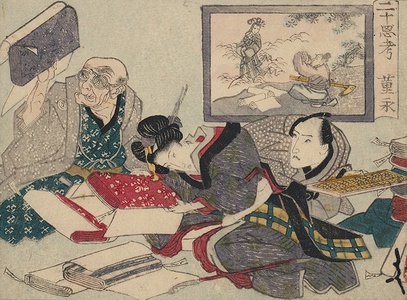| Method | Woodblock (nishiki-e) |
| Artist | Utagawa School |
| Published | c. 1840 |
| Dimensions | Yatsugiri-ban [~95 x 127 mm] |
| Notes |
A fascinating abuna-e (suggestive print) depicting a seated woman looking at kimono fabric while being aroused by a man behind and right who reaches into her kimono with his right hand while he holds a soroban (counting tray/abacus) in his left hand, an old man wearing glasses, presumably the fabric merchant, holds up a bolt of fabric seemingly unaware of what is taking place next to him. An inset image depicting the the character Dong Yong and the Heavenly Maiden. In this print the inset image and story of Dong Yong is being compared to the main image. Dong Yong was one of The Twenty-four Filial Exemplars by Chinese author Guo Jujing a classical classic text on Confucian filial piety. In this story Dong Yong's mother dies when he is little and when his father dies he sells himself into servitude to a weaver to pay for his father's funeral. Touched by his filial piety, Heaven sends a maiden who says she will marry him. The two get married and she takes his place at the loom he was working at and weaves 100 bolts of fabric in 10 days to repay his debt. In this print the sexual scene is a parody of this story. Here the son does not show filial piety but rather ignores it and subverts filial piety in the name of pleasure. This size of shunga print was usually sold in sets of twelve in paper wrappers and often given as gifts at New Year in a similar fashion to surimono (privately commissioned greetings cards).As with surimono, these prints have been made using complex deluxe printing methods such as a large range of colours, complex patterns, and metallic pigments. Shunga is the term used for the body of erotic imagery produced in Japan from 1600 to 1900. The term shunga means spring pictures and is a euphemism for sex and is one of several names for erotic material produced in Japan. Shunga took different formats: painted hand scrolls, painted books, printed books and albums and sets of prints which were sometimes sold in wrappers. As prints they are one of the genres of Ukiyo-e, or Floating World, prints which includes: fukeiga (landscape prints), and bijin-ga (prints of beautiful women). Most of the major Ukiyo-e artists produced shunga material at some point during their career including Utamaro (who produced more erotic books than non-erotic books), Hokusai, and Hiroshige. Produced at the same time as the introduction of full colour woodblock printing, shunga prints and books were made using the most lavish and complicated printing techniques including gauffage, metallic inks, mica, complicated printed patterns, and multicolour printing using a high number of different colours. Shunga whilst prolific is more representative of the idea of the Ukiyo-e or Floating World with an emphasis on mutual pleasure rather than an accurate representation of Japanese attitudes and practices of sexuality. Shunga prints present an invitation to pleasure through the bliss of lovemaking and though largely heteronormative, they portray the gambit of couplings married or otherwise often surrounded by lavish settings and objects of pleasure. Shunga is the term used for the body of erotic imagery produced in Japan from 1600 to 1900. The term shunga means spring pictures, a euphemism for sex, and is one of several names for erotic material produced in Japan. Shunga took different formats: painted hand scrolls, painted books, printed books and albums, and sets of prints which were sometimes sold in wrappers. As prints they are one of the genres of ukiyo-e, or Floating World prints, which also include fukeiga (landscape prints), and bijin-ga (prints of beautiful women). Most of the major ukiyo-e artists produced shunga material at some point during their careers, including Utamaro (who produced more erotic books than non-erotic books), Hokusai, and Hiroshige. Produced at the same time as the introduction of full colour woodblock printing, shunga prints and books were made using the most lavish and complicated printing techniques, including gauffrage, metallic inks, mica, complicated printed patterns, and multicolour printing using a high number of different colours. Although prolific in its number and variety, shunga should be seen as more representative of the ideals of the ukiyo, with its emphasis on mutual pleasure, rather than as an accurate representation of Japanese attitudes and practices of sexuality. Shunga present an invitation to pleasure through the bliss of lovemaking and though largely heteronormative, they portray the full gamut of couplings, married or otherwise, often surrounded by lavish settings and objects of pleasure. Utagawa School was the largest school of ukiyo-e art founded by Utagawa Toyoharu. After Toyoharu died his main pupil Utagawa Toyokuni I took over and led the group to become the biggest and most influential woodblock school of the 19th century. Pupils include Kunisada, Kuniyoshi, Hiroshige, and Yoshitoshi. Utagawa School is used an attribution when prints are unsigned and in the style of the school. Due to the punitive restrictions on shunga prints many works were produced without signatures or with pseudonyms. Ex. Col.: Peter Darach Conditon: Delicate colour and excellent impression, album backing, and a worm hole lower right corner. |
| Framing | mounted |
| Price | £180.00 |
| Stock ID | 53239 |

